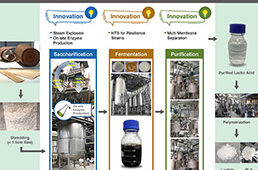A rendering of olfactory receptor proteins attached to a nanotube. Image: Robert Johnson |
University of Pennsylvania
researchers have helped develop a nanotech device that combines carbon
nanotubes with olfactory receptor proteins, the cell components in the nose
that detect odors.
Because olfactory
receptors belong to a larger class of proteins that are involved in passing
signals through the cell membrane, these devices could have applications beyond
odor sensing, such as pharmaceutical research.
The research was led by
professor A. T. Charlie Johnson, postdoctoral fellow Brett R. Goldsmith, and
graduate student Mitchell T. Lerner of the Department of Physics and Astronomy
in the School of Arts and Sciences, along with assistant professor Bohdana M.
Discher and postdoctoral fellow Joseph J. Mitala Jr. of the Department of
Biophysics and Biochemistry at Penn’s Perelman School of Medicine. They
collaborated with researchers from the Monell
Chemical Senses
Center, the University
of Miami, the University
of Illinois, Princeton University,
and two private companies: Nanosense Inc. and Evolved Machines Inc.
Their work was published
in ACS Nano.
The Penn team worked with
olfactory receptors derived from mice, but all olfactory receptors are part of a
class of proteins known as G protein coupled receptors, or GPCRs. These
receptors sit on the outer membrane of cells, where certain chemicals in the
environment can bind to them. The binding action is the first step in a
chemical cascade that leads to a cellular response; in the case of an olfactory
receptor, this cascade leads to the perception of a smell.
The Penn team succeeded
in building an interface between this complicated protein and a carbon nanotube
transistor, allowing them to convert the chemical signals the receptor normally
produces to electrical signals, which could be incorporated in any number of
tools and gadgets.
“Our nanotech devices are
read-out elements; they eavesdrop on what the olfactory receptors are doing,
specifically what molecules are bound to them,” Johnson says.
As the particular GPCR
the team worked with was an olfactory receptor, the test case for their
nanotube device was to function as sensor for airborne chemicals.
“If there’s something in
the atmosphere that wants to bind to this molecule, the signal we get through
the nanotube is about what fraction of the time is something bound or not. That
means we can get a contiguous read out that’s indicative of the concentration
of the molecule in the air,” Johnson says.
While one could imagine
scaling up these nanotube devices into a synthetic nose—making one for each of
the approximately 350 olfactory GPCRs in a human nose, or the 1,000 found in a
dog’s—Johnson thinks that medical applications are much closer to being
realized.
“GPCRs are common drug
targets,” he says. “Since they are known to be very important in
cell-environment interactions, they’re very important in respect to disease
pathology. In that respect, we now have a pathway into interrogating what those
GPCRs actually respond to. You can imagine building a chip with many of these
devices, each with different GPCRs, and exposing them all at once to various
drugs to see which is effective at triggering a response.”
Figuring out what kinds
of drugs bind most effectively to GPCRs is important because pathogens often
attack through those receptors as well. The better a harmless chemical attaches
to a relevant GPCR, the better it is at blocking the disease.
The Penn team also made a
technical advancement in stabilizing GPCRs for future research.
“In the past, if you take
a protein out of a cell and put it onto a device, it might last for a day. But
here, we embedded it in a nanoscale artificial cell membrane, which is called a
nanodisc,” Johnson says. “When we did that, they lasted for two and half
months, instead of a day.”
Increasing the lifespans
of such devices could be beneficial to two scientific fields with increasing
overlap, as the as evidenced by the large, interdisciplinary research team
involved in the study.
“The big picture is
integrating nanotechnology with biology,” Johnson says. “These complicated
molecular machines are the prime method of communication between the interior
of the cell and the exterior, and now we’re incorporating their functionality
with our nanotech devices.”





